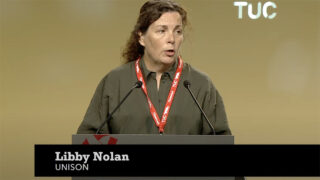UNISON has warned that the decision to axe a further 1500 Environment Agency workers is “potentially catastrophic” in the wake of yesterday’s devastating storm. The St Jude’s Day storm caused major disruption and loss of life with a clean up bill expecting to cost millions of pounds. Area staff are at the forefront of the service, protecting the public by directly maintaining rivers, deploying sandbags, giving flooding warnings, surveying protected species, dealing with pollution incidents and informing local consenting and planning.
The union, that represents 3500 staff in the Environment Agency, understands that employee numbers will be cut from 11,250 to around 9,700 by October 2014, with the possibility of further redundancies in the future as a result of a 9% reduction in Government revenue funding. Directorates within the Agency have been instructed to start reducing temporary and contract staff immediately, with a restriction on recruitment.
UNISON National Officer for the Environment Agency, Matthew Lay said:
“The storms this week should act as a warning to the Environment Agency and the public that making these cuts is not only dangerous but potentially catastrophic. There is a significant cost associated with managing flooded land, and cutting services to save money in the short term is a false economy. There’s a real danger that cutting staff will reduce the Agency to a crisis management level, with less maintenance and infrastructure to deal with emergencies. On top of this, there is a real risk of a significant loss of knowledge and emerging talent.
“With repeated flooding across the country last year, Environment Agency staff did a brilliant job, working long hours and going the extra mile despite being stretched to the limit. Making so many skilled workers redundant will seriously effect the Agency’s ability to manage incidents.
“Staff in the Agency have worked day and night to keep communities safe and prevent flooding damage, and work tirelessly to support those devastated by the aftermath. The government can’t have it both ways, praising the sterling work of members in the Agency but at the same time imposing further damaging cuts.
“The government must consider the potential consequences of environmental damage. These cuts will give a license to pollute, with potentially grave consequences for fishing stocks, particularly in rivers.”
Ruth Davies, Chair of the UNISON Water, Environment and Transport Service Group said:
“In 2010 David Cameron said he wanted the coalition to be the ‘greenest government ever’, but the Environment Agency is now facing a second phase of budget cuts under this government.
“Our members are currently facing massive uncertainty about the details of how these cuts will be implemented, but what is now clear is that between March and October 2014 the Environment Agency will be reducing staff numbers in an unprecedented downsize.
“Our managers are keen to talk with the trade unions, but understandably the morale of our members is currently at a very low ebb. From a UNISON perspective we will work with our managers at all levels to minimise the risks to our members, however with this level of job losses it is impossible to be optimistic of a positive outcome.”
The coalition government’s flawed austerity drive has already resulted in 2,000 jobs being cut from the Environment Agency. However, previous cuts were made too fast too soon, leading to some posts being reinstated.
The Environment Agency has a single job – to look after the environment and make it a better place to live. It protects homes from impending floods and warns householders, keeps river water clean for recreation and wildlife and influences or prosecutes polluters. It licenses the amount of water taken out of rivers and ensures there is enough for both human consumption and wildlife. It also regulates the waste management and nuclear energy industries.
Figures published earlier this year by the Association of British Insurers show that the cost of flood damage alone since 2000 has leapt by 200% on the previous decade.


